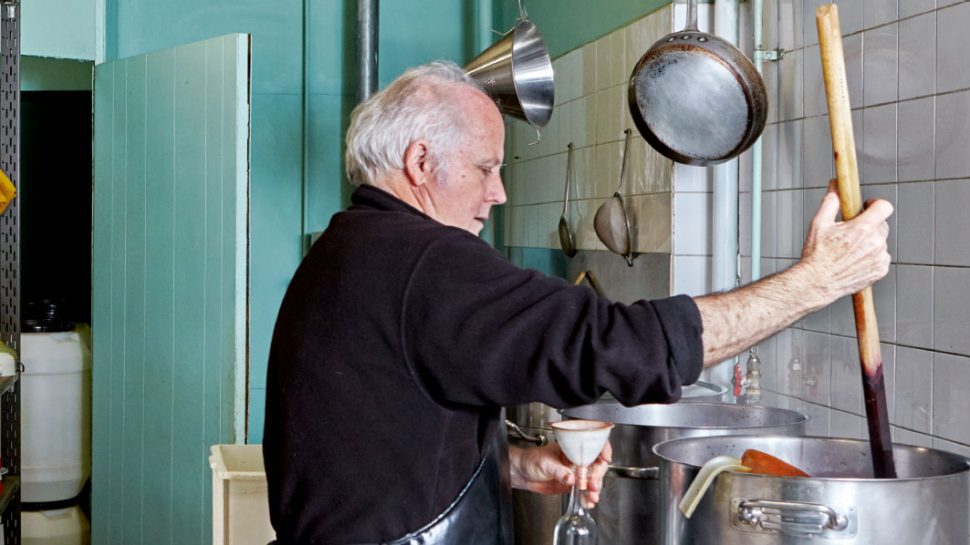Australian Harvest: the medicinal benefits of simple foods

Hippocrates’ sage advice made a particular impact on Martin Cheney, whose Yarra Valley company, Australian Harvest, very literally makes food as medicine.
Martin’s been at the forefront of health and nutrition for well over thirty years. Working for pharmaceutical companies in the 1980s, Martin was a key figure in the introduction of vitamins and supplements such as fish oil to the Australian market. He’s the founder of Bio Organics, which was bought up by Nature’s Own. Ultimately, it was that area that marked the intersection between alternative therapies and hard science that most attracted Martin. “I grew up as a bit of a hippy, and I was always interested in alternate things,” he admits. “But, I did science subjects at the University of SA, and I had a bit of genetics and microbiology background. It married food and medicine together.”
Even now, off the top of his head, Martin reels off the results of highly technical studies, annotating casual conversation with journal sources and the professors who wrote them. But for all his scientific know-how, it was the fundamental side of producing healthy food that attracted him. After selling Bio Organics, Martin and his wife Jane bought a property in the Adelaide Hills, which ran down to the banks of the Onkaparinga River. “I started growing herbs, and acres of biodynamic horseradish,” he recalls. “We were also growing french tarragon, basil.”
He began selling sun-dried tomatoes under the Australian Harvest brand, which had been organically grown, flood-irrigated from the nearby river, and grown among companion plants such as Marigold and Basil. Soon, Australian Harvest was also producing relishes and jams, and more unusual products such as their Kasundi or their Sweet Chilli Sauce. “The sweet chilli, I got the original inspiration from the Claudia Roden Middle Eastern Cookbook,” Martin admits. “We’re the only company to make a chilli sauce that’s thickened with sultanas. There’s not a lot of sugar in it, because the sugar comes from the sultanas. It’s got a beautiful rich flavour, and it’s a lovely dipping sauce for calamari or fish, or with felafel or tzatziki.”
Australian Harvest was also at the forefront of organic farming, a practice to which Martin and Jane remain deeply committed. “Whenever you muck with nature, there’s always serious consequences. The soil is a living organism, with all the microbes and yeasts. They respirate. When you spray chemicals on them, they die,” says Martin. “Every hectare of organic agriculture will sequester 7000 kilos of c02 out of the atmosphere every year. I’ve read that if all American farmers went organic, it would be equivalent to taking 230 million cars off the roads.”
While Martin enjoyed growing tasty, sustainable food, his interest in the unexplored health benefits of natural produce continued unabated. He began producing unfiltered, non-heat treated apple cider and horseradish vinegar, which some of his customers were using to treat sinus and hayfever problems.
Although drinking vinegar is a longstanding feature of traditional medicine, it’s only recently that its benefits are beginning to be understood. “What the vinegar does, is the acid converts to acetate in the gut, and that binds to receptor sites on the microflora, where allergies are initiated,” Martin explains. “Your microbiome is your second brain, and they interact with one another. They’re responsible for a whole range of biochemical reactions. That’s the reason vinegar’s so good for you, and people have been using it for hundreds of years as a tonic. We now know how it works.”
Drawing on his knowledge of vitamins and supplements, Martin began to look into the therapeutic benefits of polyphenols and antioxidants, many of which are found in high concentrations in the pigments of the skins of fruits and vegetables. “In the 80s, at that time, we thought vitamins were the bee’s knees. But we know now that the main role of vitamins is to act as co-enzymes in metabolism,” he says. “There’s still a place for vitamins, but we now know that the colour pigments in plants are 300, 400 times more powerful than Vitamin B, for example.”
The effect of polyphenols is particularly pronounced in the cardiovascular system, where they play a key role in promoting elasticity. “What the clinical research shows is that there’s a big shift in thinking – heart disease is not about cholesterol and saturated fats, it’s about localised inflammation in the arterial walls,” he explains. “We need the colour pigments from plants to protect us from disease, in terms of inflammation. That’s why the Cancer Council tells us to eat a rainbow, because cancer has its origins in inflammation.”
In order to exploit this new research, Martin began looking into ways to source these polyphenol-heavy pigments – many of which are found in the skin of wine grapes. He gathered up as much clinical evidence about the role of polyphenols and took it to the Commonwealth, who promptly awarded Australian Harvest a $100,000 grant to take skins and seeds from wine production, and extract active polyphenols from them. “We’ve had full double-blind crossover clinical trials done by Professor Peter Clifton, who heads up Diabetes Research at the Baker Institute,” says Martin. “He’s shown clinically that it improves the elasticity in the capillaries, which improves blood flow.”
More recently, Martin has been experimenting with curcumin, which is found in the yellow colour pigment of turmeric. The ingredient has been the subject of intense interest of late, with over 13000 scientific articles appearing on online medical journal database PubMed that seek to evaluate its therapeutic values. “It’s a very powerful anti-inflammatory,” Martin says.
This isn’t the same stuff you’ll find in your everyday curry or even your turmeric latte. “Normal turmeric powder only has about 3 percent curcumin and fresh turmeric about .05 percent. You’re not getting much health value when you’re eating it – it’s good for flavour when you’re eating curry or something like that,” he says. “It’s kind of a fad, because of the amount of turmeric you have to eat to get that health value is huge.”
Instead, Australian Harvest sells it as a highly-concentrated product, which is around 95 percent pure curcumin. Half a teaspoon of this stuff is equivalent to about 15 teaspoons of turmeric powder. “You can add it to your food – I love to put half a teaspoon into a smoothie, it just puts the nutritional value through the roof,” says Martin. “You can mix it with full-fat yoghurt. I’ve been using it in horseradish vinegar for hay fever and sinus problems, and we have people from around Australia who swear by it.”
And while the health benefits of these innovative, organic ingredients are front-of-mind for Martin, he’s equally committed to their taste. “I think of our products as functional products. People buy them for both culinary reasons and health reasons,” he says. “The future’s all about health and sustainability, but we’re trying to deliver that in a gourmet way, so people want to eat them”.
Shop the range of certified organic foods from Australian Harvest
